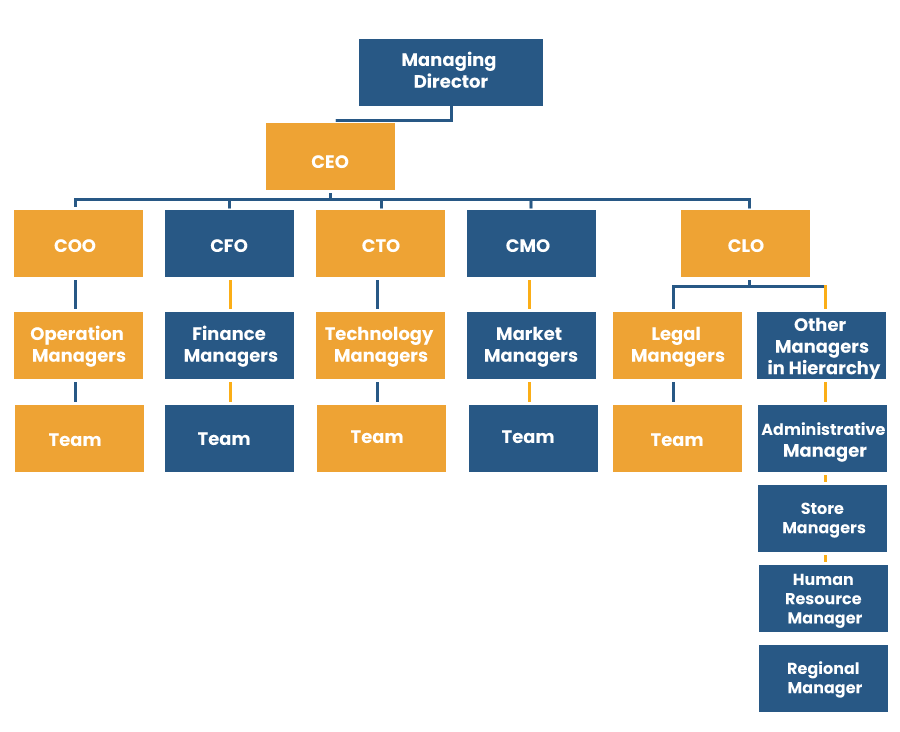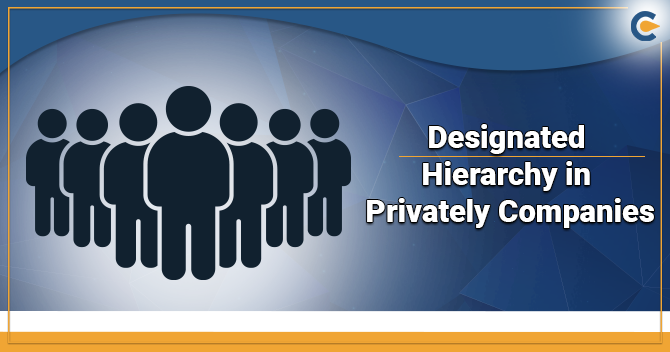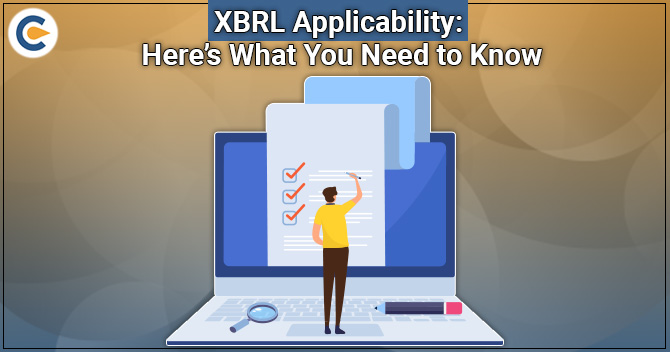The success of a business is also credited to its operating structure. From a productivity standpoint, operating a business needs a legit organizational structure to carry out the most suitable roles. The organizational structure is a prevalent factor of business success. On the other hand, established firms must delve deeper into their designated hierarchy to identify the loopholes.
Re-evaluation of the organizational structure in a privately-held entity led to the increase of performance and overall efficacy. In this write-up, we will spotlight the designated hierarchy of a privately-held entity, level of management, type of management roles.
Designation Hierarchy in Privately-held Companies
The designated hierarchy of a privately-held entity has a real impact on its sustainability and performance. Let us dive into a company’s designated hierarchy and unfolds how it operates in a general scenario.
The designated hierarchy of a privately-held entity is as follows:


The Managing Director
The director represents the company’s top-level management. These individuals are accountable for overseeing a company’s operation and are under the obligation to act in the company’s interest. A Managing Director (MD) will be appointed from the list of candidates responsible for overseeing the matters of the company.
Director is also responsible for appointing the candidates for lower-level management, such as Managers or officers. The MD will provide these individuals with their respective duties and roles.
Read our article:Private Limited Company Registration Procedure in India
Chief Executing Officer (CEO)
The Chief Operating Officer is the topmost official of a privately-held entity. He rejoices the apex position and adheres to utmost accountability to decide for the day-to-day operation of a company.
Chief Operating Officer (COO)
The Chief Operating Officer serves the second top executive position in the Designation Hierarchy. Such officials oversee the core business activities of the company.
The COO carries out the tasks such as framing policies, synchronizing the business operation, and developing operation-related strategies. These individuals are also accountable for leading operation managers under his/her supervision.
Operations Manager
Operation manager performs their duties under COO and aid in ensuring good operational efficiency in the operational activities.
Chief Financial Officer (CFO)
Chief Financial Officer is a topmost official who is responsible for managing the fiscal-related matters of the company. CFO also looks into cash flow management, internal financial control, financial strategy, and fundraising. Generally, the Finance Managers are bound to work under the supervision of these individuals.
Finance Manager
The Finance Managers are accountable for looking into the matter related to the financial operations. They are liable to report to the CFO of the company. They also look into areas like Accounting and bookkeeping.
Chief Technology Officer (CTO)
Chief Technological Officer[1] (CTO) supervises the development of technology services & products. He also manages the technological process, policies, and technological assets of the company.
Technology Manager
Technology managers perform their duties as per the directions given by the CTO of the company. They also aid in the technological development & management of the companies.
Chief Legal Officer (CLO)
As the name suggests, the legal officer is under the obligation to manage the company’s legal-related affairs. Such individuals also represent the company on the legal front. The legal department of the company is generally handled by one or more than one manager head by CLO
Legal Managers
Legal Manager performs their duties under the authority of the Chief Legal Officer and support in overseeing the company’s legal affairs.
Chief Marketing Officer (CMO)
The Chief Marketing Officer, as the name suggests, oversees the marketing front of the company. His job profile includes outlining the marketing strategies, running marketing campaigns, operating multiple marketing channels, strengthening brand image, etc.
Marketing Managers
The CMO is backed by the Marketing Managers, who are accountable for managing various marketing-related functions. They help in deploying the strategies with the help of subordinates.
Other Managers in Designated Hierarchy
There are other managers in the company apart from the managers that are helping top officials or executives. These individuals are accountable for supervising and managing individual functions. Such officials may or may not get help from the group of subordinates. These officials look into the functional & administrative of the company.
Administrative Manager
Administrative Manager is accountable for supervising the administrative functions of the company.
Store Managers
Such individuals look after the inventory management for the company.
Regional Manager
Regional managers are primarily found the large companies where business operations were carried out over a large geographical area.
Human Resource Manager
The duty of a Human resource manager is to oversee employee and their relation with the company. Their job is to maintain harmony between the employees and administration.
Role of Subordinates in Designated Hierarchy
The subordinates refer to employees that perform their duties as per the guidance conferred by the managers. They assist the Manager to execute & inculcate multiple strategies & policies.
This category comprises the largest chunk of the workforce in the business organizational structure. These people perform their job in accordance with directions coming from the top-level management. In addition to that, they function to deploy the work strategies set by managers.
A Good Hierarchy Improve Communication and Efficacy
A good hierarchy ensures seamless communication between employees, departments & divisions of the company. A manager of the respective department becomes the departmental administrator, and any detail that is significant to the department is forward to the manager.
The manager can either respond to the information or assign it to others within his/her staff. This cut down the possibility of exposing information to everyone else apart from the manager, thereby ensuring efficacy on the communication front.
Conclusion
Having a correct understanding of the Designated Hierarchy can lead to countless benefits for the company’s management. Furthermore, understanding the various officials’ roles and responsibilities within the hierarchy can help the executives perform better. Moreover, selecting the right hierarchy can ensure long-term growth for the company.
Read our article:A Complete Overview on the Types of Directors in the Privately held Organization











